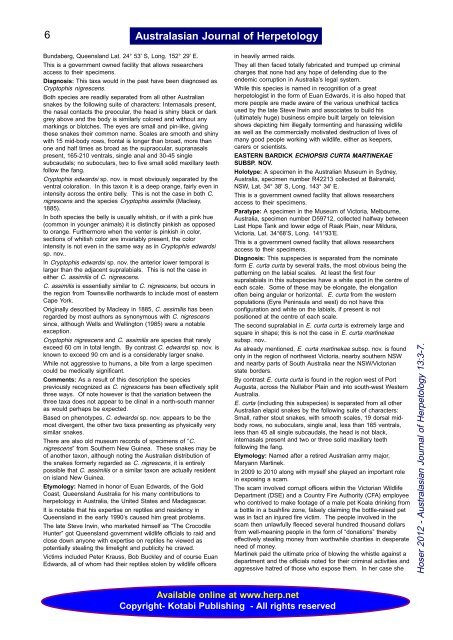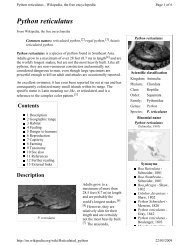Issue Thirteen 30 June 2012 - Taxonomic issue - all - Smuggled.com
Issue Thirteen 30 June 2012 - Taxonomic issue - all - Smuggled.com
Issue Thirteen 30 June 2012 - Taxonomic issue - all - Smuggled.com
You also want an ePaper? Increase the reach of your titles
YUMPU automatically turns print PDFs into web optimized ePapers that Google loves.
6<br />
Bundaberg, Queensland Lat. 24° 53' S, Long. 152° 29' E.<br />
This is a government owned facility that <strong>all</strong>ows researchers<br />
access to their specimens.<br />
Diagnosis: This taxa would in the past have been diagnosed as<br />
Cryptophis nigrescens.<br />
Both species are readily separated from <strong>all</strong> other Australian<br />
snakes by the following suite of characters: Internasals present,<br />
the nasal contacts the preocular, the head is shiny black or dark<br />
grey above and the body is similarly colored and without any<br />
markings or blotches. The eyes are sm<strong>all</strong> and pin-like, giving<br />
these snakes their <strong>com</strong>mon name. Scales are smooth and shiny<br />
with 15 mid-body rows, frontal is longer than broad, more than<br />
one and half times as broad as the supraocular, supranasals<br />
present, 165-210 ventrals, single anal and <strong>30</strong>-45 single<br />
subcaudals; no suboculars, two to five sm<strong>all</strong> solid maxillary teeth<br />
follow the fang.<br />
Cryptophis edwardsi sp. nov. is most obviously separated by the<br />
ventral coloration. In this taxon it is a deep orange, fairly even in<br />
intensity across the entire belly. This is not the case in both C.<br />
nigrescens and the species Cryptophis assimilis (Macleay,<br />
1885).<br />
In both species the belly is usu<strong>all</strong>y whitish, or if with a pink hue<br />
(<strong>com</strong>mon in younger animals) it is distinctly pinkish as opposed<br />
to orange. Furthermore when the venter is pinkish in color,<br />
sections of whitish color are invariably present, the color<br />
intensity is not even in the same way as in Cryptophis edwardsi<br />
sp. nov..<br />
In Cryptophis edwardsi sp. nov. the anterior lower temporal is<br />
larger than the adjacent supralabials. This is not the case in<br />
either C. assimilis of C. nigrescens.<br />
C. assimilis is essenti<strong>all</strong>y similar to C. nigrescens, but occurs in<br />
the region from Townsville northwards to include most of eastern<br />
Cape York.<br />
Origin<strong>all</strong>y described by Macleay in 1885, C. assimilis has been<br />
regarded by most authors as synonymous with C. nigrescens<br />
since, although Wells and Wellington (1985) were a notable<br />
exception.<br />
Cryptophis nigrescens and C. assimilis are species that rarely<br />
exceed 60 cm in total length. By contrast C. edwardsi sp. nov. is<br />
known to exceed 90 cm and is a considerably larger snake.<br />
While not aggressive to humans, a bite from a large specimen<br />
could be medic<strong>all</strong>y significant.<br />
Comments: As a result of this description the species<br />
previously recognized as C. nigrescens has been effectively split<br />
three ways. Of note however is that the variation between the<br />
three taxa does not appear to be clinal in a north-south manner<br />
as would perhaps be expected.<br />
Based on phenotypes, C. edwardsi sp. nov. appears to be the<br />
most divergent, the other two taxa presenting as physic<strong>all</strong>y very<br />
similar snakes.<br />
There are also old museum records of specimens of “C.<br />
nigrescens” from Southern New Guinea. These snakes may be<br />
of another taxon, although noting the Australian distribution of<br />
the snakes formerly regarded as C. nigrescens, it is entirely<br />
possible that C. assimilis or a similar taxon are actu<strong>all</strong>y resident<br />
on island New Guinea.<br />
Etymology: Named in honor of Euan Edwards, of the Gold<br />
Coast, Queensland Australia for his many contributions to<br />
herpetology in Australia, the United States and Madagascar.<br />
It is notable that his expertise on reptiles and residency in<br />
Queensland in the early 1990’s caused him great problems.<br />
The late Steve Irwin, who marketed himself as “The Crocodile<br />
Hunter” got Queensland government wildlife officials to raid and<br />
close down anyone with expertise on reptiles he viewed as<br />
potenti<strong>all</strong>y stealing the limelight and publicity he craved.<br />
Victims included Peter Krauss, Bob Buckley and of course Euan<br />
Edwards, <strong>all</strong> of whom had their reptiles stolen by wildlife officers<br />
Australasian Journal of Herpetology<br />
in heavily armed raids.<br />
They <strong>all</strong> then faced tot<strong>all</strong>y fabricated and trumped up criminal<br />
charges that none had any hope of defending due to the<br />
endemic corruption in Australia’s legal system.<br />
While this species is named in recognition of a great<br />
herpetologist in the form of Euan Edwards, it is also hoped that<br />
more people are made aware of the various unethical tactics<br />
used by the late Steve Irwin and associates to build his<br />
(ultimately huge) business empire built largely on television<br />
shows depicting him illeg<strong>all</strong>y tormenting and harassing wildlife<br />
as well as the <strong>com</strong>merci<strong>all</strong>y motivated destruction of lives of<br />
many good people working with wildlife, either as keepers,<br />
carers or scientists.<br />
EASTERN BARDICK ECHIOPSIS CURTA MARTINEKAE<br />
SUBSP. NOV.<br />
Holotype: A specimen in the Australian Museum in Sydney,<br />
Australia, specimen number R42213 collected at Balranald,<br />
NSW, Lat. 34° 38' S, Long. 143° 34' E.<br />
This is a government owned facility that <strong>all</strong>ows researchers<br />
access to their specimens.<br />
Paratype: A specimen in the Museum of Victoria, Melbourne,<br />
Australia, specimen number D59712, collected halfway between<br />
Last Hope Tank and lower edge of Raak Plain, near Mildura,<br />
Victoria, Lat. 34°68’S, Long. 141°93’E.<br />
This is a government owned facility that <strong>all</strong>ows researchers<br />
access to their specimens.<br />
Diagnosis: This supspecies is separated from the nominate<br />
form E. curta curta by several traits, the most obvious being the<br />
patterning on the labial scales. At least the first four<br />
supralabials in this subspecies have a white spot in the centre of<br />
each scale. Some of these may be elongate, the elongation<br />
often being angular or horizontal. E. curta from the western<br />
populations (Eyre Peninsula and west) do not have this<br />
configuration and white on the labials, if present is not<br />
positioned at the centre of each scale.<br />
The second supralabial in E. curta curta is extremely large and<br />
square in shape; this is not the case in E. curta martinekae<br />
subsp. nov..<br />
As already mentioned, E. curta martinekae subsp. nov. is found<br />
only in the region of northwest Victoria, nearby southern NSW<br />
and nearby parts of South Australia near the NSW/Victorian<br />
state borders.<br />
By contrast E. curta curta is found in the region west of Port<br />
Augusta, across the Nullabor Plain and into south-west Western<br />
Australia.<br />
E. curta (including this subspecies) is separated from <strong>all</strong> other<br />
Australian elapid snakes by the following suite of characters:<br />
Sm<strong>all</strong>, rather stout snakes, with smooth scales, 19 dorsal midbody<br />
rows, no suboculars, single anal, less than 165 ventrals,<br />
less than 45 <strong>all</strong> single subcaudals, the head is not black,<br />
internasals present and two or three solid maxillary teeth<br />
following the fang.<br />
Etymology: Named after a retired Australian army major,<br />
Maryann Martinek.<br />
In 2009 to 2010 along with myself she played an important role<br />
in exposing a scam.<br />
The scam involved corrupt officers within the Victorian Wildlife<br />
Department (DSE) and a Country Fire Authority (CFA) employee<br />
who contrived to make footage of a male pet Koala drinking from<br />
a bottle in a bushfire zone, falsely claiming the bottle-raised pet<br />
was in fact an injured fire victim. The people involved in the<br />
scam then unlawfully fleeced several hundred thousand dollars<br />
from well-meaning people in the form of “donations” thereby<br />
effectively stealing money from worthwhile charities in desperate<br />
need of money.<br />
Martinek paid the ultimate price of blowing the whistle against a<br />
department and the officials noted for their criminal activities and<br />
aggressive hatred of those who expose them. In her case she<br />
Available online at www.herp.net<br />
Copyright- Kotabi Publishing - All rights reserved<br />
Hoser <strong>2012</strong> - Australasian Journal of Herpetology 13:3-7.



